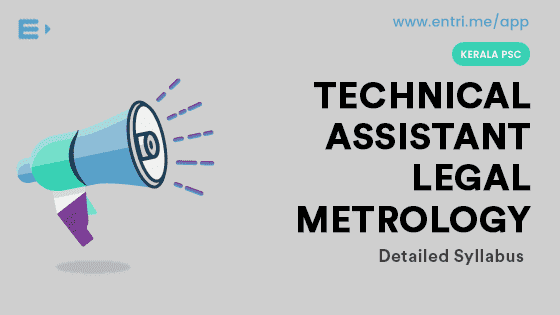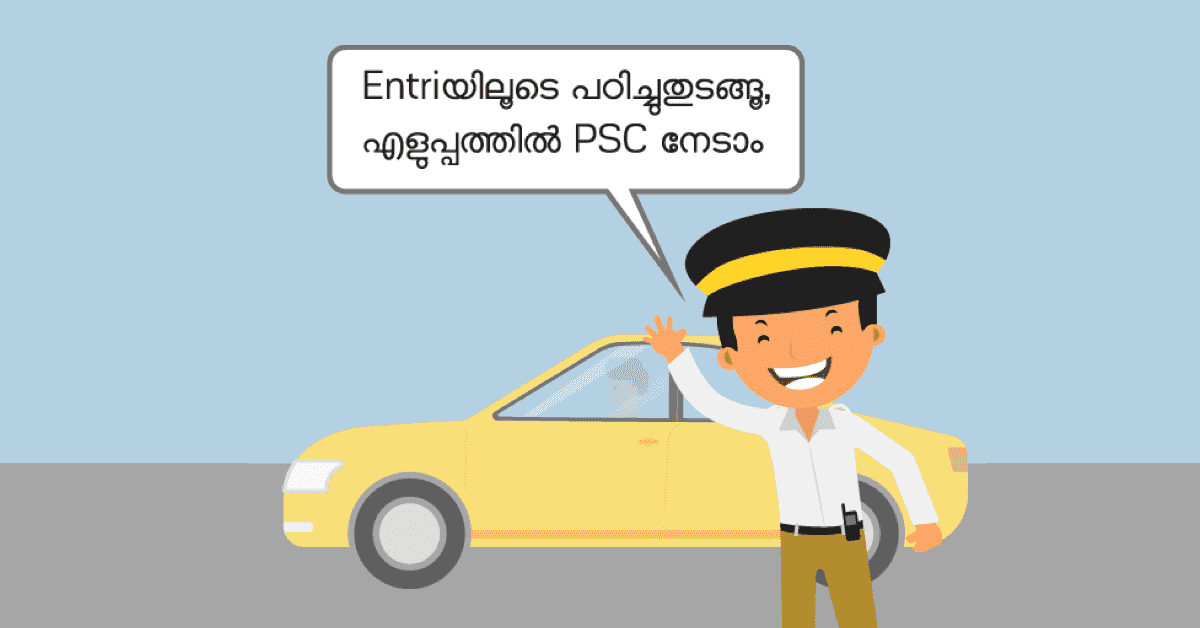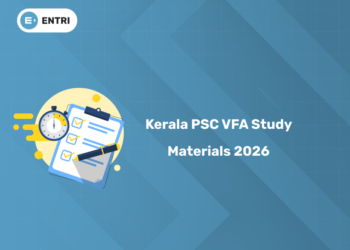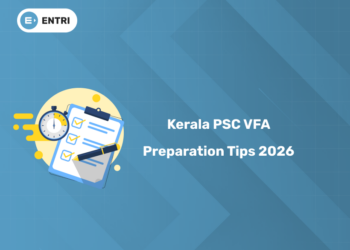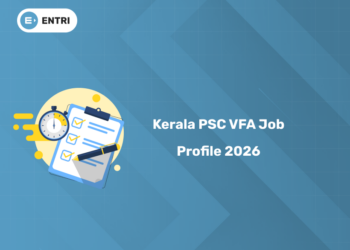Table of Contents
The Kerala Public Service Commission is one of the most reputable government job organizations in Kerala.
The detailed syllabus of Kerala PSC Technical Assistant Legal Metrology is given below.
Technical Assistant Legal Metrology Exam Syllabus
Main Topics:
[table id=75 /]
Detailed Syllabus
1: Which Year First Assembly Election was held in Kerala?
Part 1: General Knowledge, Current Affairs and Renaissance in Kerala
Indian Constitution-Salient features:
• Salient features of Indian Constitution, Preamble and it’s significance and place in the interpretation of Indian Constitution.
• Fundamental Rights, Directive principles of state policy, Relation between Fundamental Rights and Directive Principles, Fundamental Duties.
• Executive, Legislature, Judiciary, both at Union and State Level, Other Constitutional Authorities.
• Center-State Relations, Legislative, Administrative and Financial services under the Union and States, Emergency Provisions, Amendment Provisions of the Constitution.
Social Welfare- Legislations and Programmes:
• Social Service Legislations: Right to Information Act, Prevention of atrocities against Women and Children, Food Security Act.
• Social Welfare Programmes: Employment Guarantee Programme, Organ and Blood Donation etc.
Renaissance In Kerala
Towards a New Society:
• Introduction to English Education, Missionary Organizations and their functioning, Establishment of Educational Institutions, factories, printing press etc.
Efforts to reform the society:
• SOCIO-RELIGIOUS REFORM MOVEMENTS: SNDP Yogam, Nair Service Society, Yogakshema Sabha, adhu Jana Paripalana Sangham, Vaala Samudaya Parishkarana Sabha, Samathwa samajam, Islam Dharma Paripalana Sangham, Prathyaksha Raksha Daiva Sabha, Sahodara Prasthanam etc.
• STRUGGLES AND SOCIAL REVOLTS: Upper Cloth revolts, Channar Agitation, Vaikom Sathyagraha, Guruvayur Sathyagraha, Paliyam Sathyagraha, Kuttamkulam Sathyagraha, Temple Entry Proclamation, Temple Entry Act, Malayalee Memorial, Ezhava Memorial etc.
Malabar Riots, Abstention Movement, Civil Disobedience Movement etc.
Role of Press in Renaissance: Al-Ameen, Bhashaposhini, Kerala Kaumudy, Kesari, Malayala Manorama, Malayalee, Mathrubhoomi, Mithavadi, Prabhatham, Samadarsini, Swadeshabhimani, Swaraj, Yukthivadi etc.
Awakening Through Literature: Poetry, Novel, Drama, Purogamana Sahithya Prasthanam, Nataka Prasthanam, Library Movement etc.
Women and Social Change: Lalithambika Antharjanam, Akkamma Cheriyan, A V Kuttimalu Amma, Anna Chandi, Parvathi Nenmenimangalam, Arya Pallam, Lalitha Prabhu and others.
Leaders of Renaissance: Thycaud Ayya Vaikundar, Sree Narayana Guru, Ayyan Kali, Chattampi Swamikal, Vaghbadananda, Poikayil Yohannan(Kumara Guru), Vakkom Abdul Khadar Maulavi, Bhramananda Sivayogi, Dr. Palpu, Sahodaran Ayyapan, Pampadi John Joseph, Palakunnath Abraham Malpan, Mampuram Thangal, Pandit K P Karuppan, Mannathu Padmanabhan, V T Bhatttathirippad, Makthi Thangal, Blessed Elias Kuriakose Chaavara, T K Madhavan, K P Keshava Menon, Barrister G P Pillai, Moorkoth Kumaran, C Krishnan, Dr Ayyathan Gopalan, C V Kunjuraman, Kuroor Neelakandan Namboothiripad, Velukkutty Arayan, K P Vellon, P K Chathan Master, K Kelappan, P KrishnaPillai, A K Gopalan, T R Krishna Swami Iyer, C Kesava, Swami Anana Theerthan, M C Joseph, Kuttipuzha Krishnapillai and others.
Literary Figures: Kodungallur Kunhikuttan Thampuran, Kerala Varma Valiyakoyi Thampuran, Kandathil Varghese Mappila, Kumaranasan, Vallathol Narayana Menon, Ullur Sri Paramaeswaran Iyer, G Sankara Kurup, Changampuzha Krishna Pillai,Chandu Menon, Vaikom Muhammad Basheer, Kesav Dev, Thakazhi Sivasankara Pillai, Ponkunnam Varky, S K Pottakad and others.
General Knowledge and Current Affairs
Part 2: Mechanical Engineering
Module I:
Properties of Materials: Physical, Chemical, Mechanical, Thermal and Electrical Properties.
Testing of Materials: Destructive and Non Destructive Testing.
Measuring Instruments: Vernier Calliper, Micrometer, Vernier height and depth Gauge, Precision and Nonprecision Instruments.
Classification of Gauges: Plug Gauge, Ring Gauge, Snap Gauge, Screw Pitch Gauge, Feeler Gauge, Standard Wire Gauge.
Comparators: Mechanical/Electrical / Optical Comparators (Only Working)
Welding: Classification of Welding, Advantages of Welding, Limitations of Welding, Principle of Arc Welding, Arc Welding Machines-DC Generator and C Transformers (Only Working).
Gas Welding: Oxyacetylene Welding (Only Description), Gases used types of flames and it’s uses, Submerged Arc Welding, MIG, and TIG welding (only description).
Defects of Welding: Causes of defects, Remedies of defects, Soldering, and Brazing (brief description),
Foundry: Foundry tools and it’s used, Types of molding sand, Moulding processes-Bench molding, Pit molding, Floor molding, Sweep molding.
Allowances on Pattern: Shrinkage, Draft machining, distortion and rapping allowances.
Forging Operations: Upsetting, Drawing down, and Setting down, Punching, Welding and Cutting (Only description).
Fitting: Tools used and their uses-files, punches, vice, chisels, hammers, surface plate, surface gauge, V-Block, Combination Set, drills, calipers, taps and dyes, reamers
Metals and Alloys: Types of cast iron, properties, application of cast Iron, List of various types of steels –Low carbon Steels, Medium Carbon Steel, Stainless Steel, High Carbon Steel and Magnetic Steel, Non Ferrous Metals and Alloys of aluminium and Copper(Brief description), Heat Treatment-Annealing, Normalizing, Hardening, Tempering, Case Hardening(Only description).
Metal Cutting: Difference between Orthogonal and Oblique cutting, Cutting speed, feed depth of cut (only definition), Properties of cutting tool materials.
Lathe: Types/Parts/Specifications of Lathe, Operations on Lathe-Turning, Taper Turning, Facing, Boring, Drilling, Threading and Reaming, Tools and work holding devices used in Lathe.
Module II:
Properties of Fluids: Density, Specific Weight, Specific Volume, Specific Gravity (Simple Problems)
Fluid Pressure and it’s Measurement : Pressure, Atmospheric Pressure, Absolute Pressure, Gauge Pressure, Pascal’s Law(Definition), Simple problems on pressure measurement by Piezo Meter Tube, Simple Manometer and Differential Manometer, Bernoulli’s Theorem statement and simple problems, Bernoulli’s equation, Continuity equation, Working of venturimeter, Orifice meter and Pitot tube(simple problems)
Orifices: Types of Orifices, Vena Contracta, Coefficient of contract, Coefficient of Velocity, Coefficient of Discharge with simple problems.
Notches: Rectangular/Triangular Notches and discharge over Notches with simple problems.
Losses of Head in Pipes: Major and Minor losses, Loss of energy due to friction, Darcy’s formula for loss of head in pipes.Chezy’s formula (simple problems).
Turbines: Classification of Turbines, Impulse and Reaction Turbines, Classification of reaction Turbines, Draft Tube uses, Pelton Wheel and Francis Turbine (Working).
Pumps: Working of different types of Pumps, Air vessels (Function), Foot Valve and Strainer, Slip of a pump.
Stress and Strain: Definition of Stress, Strain, Longitudinal Strain, Lateral Strain, Poisson’s Strain, Factor of Safety, Statement of Hook’s Law(Simple problem’s).
Friction: Types of Friction, Law’s of Friction, Angle of Friction, Coefficient of Friction, Coefficient of Friction, Limiting Friction (Simple problems).
Module III:
Boiler: Boiler definition, Function of Boiler, Classification of Boiler, Comparison of Boilers, Specifications of Boiler, Mountings and Accessories (Working and functions only).
Properties of Steam: Wet steam, Dry steam, Superheating steam, Dryness fraction (Only definition), Working of Steam Engine, Steam Nozzles function, Steam turbines- Classification and Working.
Steam condensers: Working with Jet and Surface Condensers.
Power Plants: Types of Power Plants like Hydroelectric, Thermal, Nuclear and Diesel Power Plants.
Renewable Energy Sources: Solar Energy
Management: Management meaning, a contribution of F W Taylor, Taylor’s Contribution, Henry Fayol’s Principle of Management.
Different Types of Ownership: Sole proprietorship, Partnership, Private Limited Company, Public Limited Company (Brief description).
Organizational Structure: Line Organization, Functional Organization, Line and Staff Organization.
Objectives of Training: Methods of Training (Explanation)
Wages: Good Wage Plan and it’s importance, Wage types, Systems of Wage payment.
Incentives: Explanation of Straight piece rate system, Time rate system, Piece rate system with guaranteed minimum wage and Differential piece rate system. IC and EC engines(differentiation), working of four-stroke petrol engine and diesel engine, two stroke petrol engine, two-stroke diesel engine, comparison of petrol and diesel engine, comparison of two strokes and four stroke engine. Functions of carburetor and fuel injector.
Classification of cooling systems: Air cooling and water cooling system, Functions of radiator and Thermostat.
Governing of IC Engines: Quantity and Quality governing, Hit and miss governing.
Transmission Systems: Clutch, Flywheel, Gear box, Propeller shaft and Differential (Functions).
Fundamentals of Thermodynamics: Concept of the system in thermodynamics. Open, Closed, Isolated systems, Intrinsic and Extrinsic Properties, Laws of Thermodynamics, Laws of perfect gases, thermodynamic processes-Constant volume and constant pressure process, Adiabatic and Isothermal process( Explanation only).
Refrigeration: Refrigeration purposes, Unit of Refrigeration, Concept of the cop. Working on air compression refrigeration system based on Reversed Carnot cycle and Bell Coleman cycle with simple problems, Working of Vapour compression refrigeration system.
Part 3: Instrumentation
Module I:
Generalized Instrumentation System: Primary sensing, Variable conversion, Data transmission, Variable manipulation, Data presentation elements with examples, Classification of instruments like Absolute and secondary Instruments, Null and Deflection Instruments, Analog and Digital Instruments, Indication, recording and controlling functions of instruments. Units of various electrical and non electrical quantities, Standard of measurements, international Standards, Primary/Secondary/Working standards, Static characteristics, Accuracy, Precision, Sensitivity, Linearity, resolution, Hysteresis, Drift, Reproducibility etc with problems to calculate these parameters, Limiting Error, relative limiting error, Gross error, Random error.
Module II:
Transducer: Classification of Transducers-Active e,Passive, Analog and Digital, Sensors and Transducers, Mechanical and Electrical transducers with examples, Principle of resistive transducers, Principle of operation of linear and rotatory potentiometer, Sensitivity of linear and Rotary potentiometer, Loading effect, Strain gauges, Expression for gauge factor, Types of strain gauges, Advantages and disadvantages of semiconductor strain gauges, Strain gauge bridge circuit.
Module III:
Variable Inductance Transducer: Classification of Inductive transducers, Variable reluctance and Variable Eddy current inductive transducer, LVDT- Construction ,W orking and Applications, Different types of magnetic transducers, Working of search coils, Operation of Magneto-Resistive Transducer, magneto resistive and magneto strictive transducer, Hall Effect transducer.
Module IV:
Variable Capacitor Transducer: Variable area, Variable distance, Variable dielectric type capacitors and their working, Differential capacitive transducer, Applications of variable capacitive transducer, Piezo electric effect, Principle of operation of Piezo electric transducers, Equivalent circuit pressure measurement, Accelerometer applications, Photoelectric effect, Working of Photo emissive cell , Conductive cell, Photo voltaic cell, Photo multiplier tube and Solar cells, Applications of photoelectric transducers.
Module V:
Pressure Measurement: Pressure, Pressure head, Different types of pressure, Units of pressure, conversion of units of pressure, Classification of manometers, Working of U tube manometers, Well type manometers, Inclined manometers, Bell type manometers, Errors in manometers, Constructional details and working of C type, Spiral and helical Bourdon gauges, Bellows, Diaphrams and capsules, Calibration of pressure gauge using Dead weight Tester, Strain gauges, Capacitive type Pressure gauge, Piezo electric pressure sensor, Fiber optic pressure sensor, Differential pressure transmitter for pressure measurement, Construction and working of McLeod gauge, Pirani gauge and Ionization gauge.
Module VI:
Level Measurement: Sight glass technique, Float type level indicator method, Displacer and torque tube type level indicator, Air purge type level indicator, Capacitive and conductive level indicator, Ultra sonic level gauge, Strain gauges, Capacitive type level indicator, Radiation absorption method and laser method used for level indication fiber optic level sensor, Level switch, Differential pressure type level transmitter, Calibration of level detectors.
Module VII:
Temperature Measurement: Temperature definition, Temperature scales and conversion, Bimetallic thermometer working, Working of Mercury in glass thermometer , Mercury in steel thermometer, Gas and Vapour pressure thermometer, Radiation pyrometer, Optical pyrometer-Construction and working, PTC and NTC, Construction and working of resistance temperature detector, RTD Different types, (Ni, Cu & Pt), Characteristics of RTD, Thermistor and it’s types, Characteristics and applications of Thermistor, See beck effect, Peltier effect, Thomson effect, Laws of Thermocouple, Law of intermediate temperature and law of intermediate metals, Industrial thermocouples-different types- J, T, K, S, R, Properties of different types, Thermopile, Comparison of Thermocouple, RTD and Thermistor characteristics.
Module VIII:
Flow Measurement: Principles of flow measurements, Laminar and Turbulent flow, Reynold’s Number, Continuity equation, Bernoulli’s equation (ideal fluid), Variable area flow meters, Rota meter, Variable head flow meter, Different types of Orifice plate and tapings, Orifice plate flow meter, Venturimeter, Flow nozzle, Dahl tube, Pitot tube, Differential pressure flow transmitter, Special type flow meters, Electromagnetic flow meters, Turbine flow meter, Mass flow meter, Ultrasonic flow meter, Vortex flow meter, Hot wire anemometer, Positive displacement flow meters, Oval gear nutating disc type, Reciprocating Piston type, Open channel flow meters, Weirs, Vand Rectangular notch.
Module IX:
Viscosity and Humidity measurement: Absolute viscosity, Kinematic viscosity, Relative viscosity,, Units, Say bolt Viscometer, Redwood viscometer, Measurement of Specific gravity(definition also), Static pressure operated mechanisms, Weighing tube type, Hydrometer , Humidity measurement, Definition of humidity, Relative humidity and Absolute humidity, Dew point measurement methods, Wet and dry bulb method, Sling pshycometer, Hair hygrometer, Resistive hygrometer, Dew cell, Cold mirror method, Moisture measurement, Definition, Capacitive hygrometer method.
Module X:
Force Measurement: Load cells, Hydraulic, Pneumatic, Strain gauge load cells, Speed measurement classifications, Mechanical Tachometer, Stroboscope, Non contact method, Torque measurement technique using strain gauge, Acceleration measurement, Seismic accelerometer, LVDT accelerometer, Piezoelectric accelerometer.
Module XI:
Ph Measurement: Introduction, Sorenson’s scale, Buffer solution, Electrodes for pH measurements, Measuring electrode, Hydrogen electrode, Glass electrode, Errors and it’s compensation in glass electrode, Calomel electrode, Combined pH electrode, Industrial electrode assemblies, DIP and flow type Digital pH meter, pH control in effluent treatment, Chromatography and it’s classification, Gas chromatography, Liquid chromatography, Paper chromatography.
Part 4: Electronics
Basic Electronics: Study of resistors, capacitors, inductors, transformers-Conductors, Insulators, Semiconductors, Intrinsic and extrinsic semiconductor, Doping, Majority and minority carriers, V-I Characteristics of Diode-Principle of rectification, Different types of rectifiers, Different types of transistors and configuration.
Digital Electronics: Different Number systems and conversions from one to other, Boolean algebra, Reduction of Boolean expression, Different logic families, Adders and Subtractors, Multiplexer and De Multiplexer, Encoder and Decoder, Flip-flops, Shift register, Counters, Different types of memories.
Linear Integrated Circuits: Op-Amp Basics and different applications-adder, subtractor, detector, rectifiers, integrator, differentiator etc.
Candidates are advised to keep checking the Entri blog for more updates and start preparing through Entri App
All the best for your Exams!
Team Entri.me


